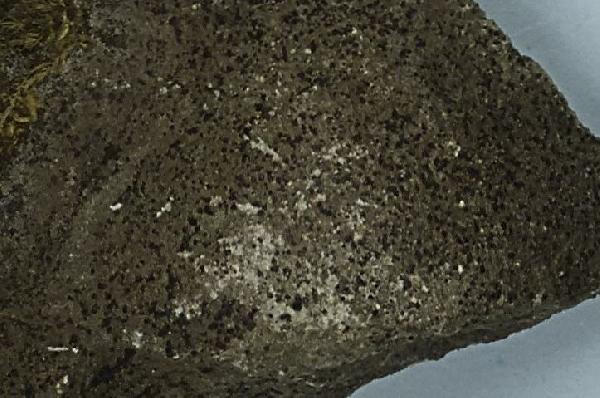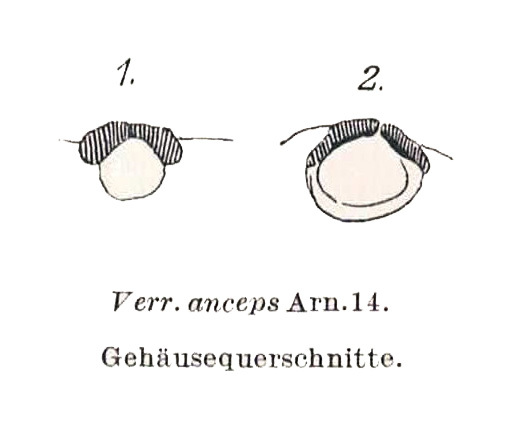Verrucaria anceps Kremp.
in Hepp, Flecht. Eur.: nr. 686, 1860.
Synonyms: Polyblastia anceps (Kremp.) Servít
Description: Thallus crustose, endosubstratic or hemiendosubstratic, continuous to rimose-areolate, ochre-grey to brown, more or less sharply delimited. Cortex 10-20 μm thick, sometimes overlain by a thin (-5 μm) epinecral layer; algal layer c. 80 μm thick. Perithecia very numerous (to 400/cm²), 1-2 per areole, ½–¾ immersed, leaving shallow pits in the rock, the visible part c. 0.2 mm across, flattened to hemispherical, black, somehow shiny, depressed around the ostiole. Involucrellum reaching at least to mid-level, adpressed to slightly diverging from exciple at base, rather homogeneously thick (30-50 μm), sometimes somewhat thinner or thicker (-70 μm) in lower part; exciple globose, 0.15-0.20 mm across, the wall colourless to brownish 10-15 μm thick; hamathecium of simple, 20-30 μm long, thin periphyses and periphysoids, interascal filaments absent; hymenial gel hemiamyloid, I+ red (I+ blue at very low concentrations of I), K/I+ blue. Asci 8-spored, clavate, I-, fissitunicate, the wall thickened above, with an ocular chamber, dehiscent by extrusion of an endotunica to form a delicate rostrum, Verrucaria-type. Ascospores 1-celled, hyaline, narrowly ellipsoid, 17-24 x (6-)7-9 μm. Photobiont chlorococcoid. Spot tests: K-, C-, KC-, P-, UV-. Chemistry: without lichen substances.
Growth form: Crustose endolithic
Substrata: rocks
Photobiont: green algae other than Trentepohlia
Reproductive strategy: mainly sexual
Poorly known taxon in need of further study
Commonnes-rarity: (info)
Alpine belt: absent
Subalpine belt: very rare
Montane belt: rare
Dry submediterranean belt: very rare
Humid submediterranean belt: absent
Padanian area: absent
pH of the substrata:
1 2 3 4 5
Solar irradiation:
1 2 3 4 5
Aridity:
1 2 3 4 5
Eutrophication:
1 2 3 4 5
Poleotolerance:
0 1 2 3
Altitudinal distribution:
1 2 3 4 5 6
Rarity
absent
extremely rare
very rare
rare
rather rare
rather common
common
very common
extremely common
Loading data...
Occurrence data
Predictive map
Growth form: Crustose endolithic
Substrata: rocks
Photobiont: green algae other than Trentepohlia
Reproductive strategy: mainly sexual
Poorly known taxon in need of further study
Commonnes-rarity: (info)
Alpine belt: absent
Subalpine belt: very rare
Montane belt: rare
Dry submediterranean belt: very rare
Humid submediterranean belt: absent
Padanian area: absent
pH of the substrata:
| 1 | 2 | 3 | 4 | 5 |
Solar irradiation:
| 1 | 2 | 3 | 4 | 5 |
Aridity:
| 1 | 2 | 3 | 4 | 5 |
Eutrophication:
| 1 | 2 | 3 | 4 | 5 |
Poleotolerance:
| 0 | 1 | 2 | 3 |
Altitudinal distribution:
| 1 | 2 | 3 | 4 | 5 | 6 |
Rarity
absent
extremely rare
very rare
rare
rather rare
rather common
common
very common
extremely common
Loading data...
Occurrence data
Predictive map








